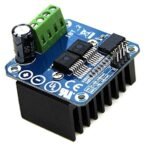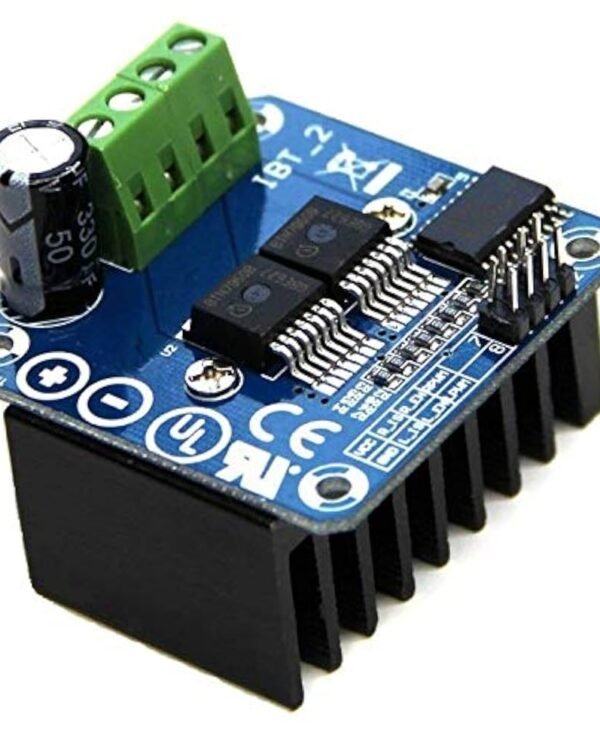The double BTS7960 43A H-Bridge High-Power Stepper Motor Driver Module is; a fully integrated high current H bridge for motor drive applications using the double BTS7960 high current half bridge. the double BTS7960 is part of the NovalithICTM family. This containing one p-channel high side MOSFET and one n-channel low side MOSFET; with an integrated driver IC in one package. Due to the p-channel high side switch; the need for a charge pump is eliminated thus minimizing EMI.
Interfacing to a microcontroller is made easy by the integrated driver IC which features logic level inputs; diagnosis with current sense, slew rate adjustment; dead time generation and protection against overtemperature, overvoltage, under voltage; overcurrent, and short circuit.
The double BTS7960 43A H-Bridge High-Power Stepper Motor Driver Module provides; a cost-optimized solution for protected high current PWM motor drives with very low board space consumption.
Features:
- PWM capability of up to 25 kHz combined with active freewheeling.
- Switched mode current limitation for reduced power dissipation in overcurrent.
- Status flag diagnosis with current sense capability.
- Overtemperature shut down with latch behavior.
- Overvoltage lockout.
- Undervoltage shut down.
- Driver circuit with logic level inputs.
- Adjustable slew rates for optimized EMI.
- 74AHC244 Schmitt-trigger Octal buffer/line driver for ESD protection (Inputs accepts voltages higher than VCC).
Input Port:
- RPWM: forward level or PWM signal input, active high.
- LPWM: Reverse level or PWM signal input, active high.
- R_EN: forward drive enable input, high-level enable, low level off.
- L_EN: Reverse drive enable input, high-level enable, low level off.
- R_IS: forward drive current alarm output.
- L_IS: Reverse drive current alarm output.
- VCC: +5 V power output, 5V power supply connection with the microcontroller.
- GND: signal common low end.
Usage Tips of double BTS7960 43A High Power Motor Driver Module:
When using the double BTS7960 43A High Power Motor Driver Module, here are some tips to ensure proper usage and maximize its performance:
- Power Supply Voltage: Ensure that the power supply voltage is within the specified operating range mentioned above. Operating the module outside the recommended voltage range may result in damage.
- Motor Specifications: Match the motor specifications with the capabilities of the double BTS7960 module. Check the voltage and current requirements of your DC motors to ensure compatibility.
- Current Sensing: Utilize the current sensing feature to monitor the current flowing through the motors. This can be useful for feedback control and protection purposes.
- Enable/Disable Functionality: Take advantage of the enable/disable function (EN pin) to selectively turn the motor driver on or off. When no force is applied to the motor and you can turn it off, use this to prevent the motors from overheating.
- Heat Dissipation: The double BTS7960 module may generate heat during operation. Provide adequate heat sinking or cooling measures, if necessary, especially if operating at high currents or for extended periods.
- Physical Mounting: Securely mount the module, ensuring good electrical connections and preventing shorts. Pay attention to the module’s physical orientation and mounting holes.
- Testing and Calibration: Before integrating the motor driver into your main system, perform initial testing and calibration to ensure proper functionality. Confirm that the motors respond as expected to control signals.
- Grounding: Properly connect the ground (GND) of the motor driver to the ground of your control circuit. Maintaining a common ground reference is essential for stable operation.
What you will need to use this motor driver module?
To use the double BTS7960 43A High Power Motor Driver Module, you will need several components and considerations to ensure proper functionality and safety in your motor control system. Here’s a general list of what you’ll need:
- DC Motors: Choose DC motors that are compatible with the voltage and current ratings supported by the double BTS7960 module. Ensure that the motor specifications match the capabilities of the motor driver.
- Power Supply: Provide a stable and regulated power supply within the specified voltage range mentioned above. The power supply should be capable of delivering the required current for the motors. You can choose and buy power supply from here.
- Microcontroller or PWM Source: Use a microcontroller or any PWM signal source to generate control signals for the motor driver. This can be an Arduino, Raspberry Pi, ESP32/ESP8266 or any other microcontroller platform capable of generating PWM signals.
- Control Interface Wiring: Connect the PWM and direction control pins of the motor driver module to the corresponding pins on your microcontroller. Ensure correct wiring for motor speed and direction control.
- Motor Wiring: Connect the DC motors to the output terminals of the motor driver module. Pay attention to the polarity to ensure the motors rotate in the desired direction.
Datasheet: https://www.handsontec.com/dataspecs/module/DOUBLE BTS7960%20Motor%20Driver.pdf





Reviews
Clear filtersThere are no reviews yet.